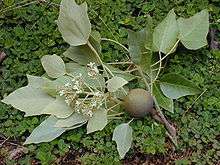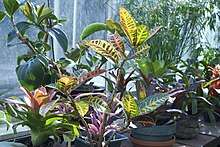Euphorbiaceae
The Euphorbiaceae are a large family, the spurge family, of flowering plants. In common English, they are sometimes called euphorbias,[2] which is also the name of a genus in the family. Most spurges such as Euphorbia paralias are herbs, but some, especially in the tropics, are shrubs or trees, such as Hevea brasiliensis. Some, such as Euphorbia canariensis,[3]:206 are succulent and resemble cacti because of convergent evolution.[4] This family occurs mainly in the tropics, with the majority of the species in the Indo-Malayan region and tropical America a strong second. A large variety occurs in tropical Africa, but they are not as abundant or varied as in the two other tropical regions. However, the Euphorbiaceae also have many species in nontropical areas such as the Mediterranean Basin, the Middle East, South Africa, and the Southern United States.
| Euphorbiaceae | |
|---|---|
 | |
| Parts of the candlenut tree (Aleurites moluccana) | |
| Scientific classification | |
| Kingdom: | Plantae |
| Clade: | Tracheophytes |
| Clade: | Angiosperms |
| Clade: | Eudicots |
| Clade: | Rosids |
| Order: | Malpighiales |
| Family: | Euphorbiaceae Juss.[1] |
| Subfamilies | |

Description


The leaves are alternate, seldom opposite, with stipules. They are mainly simple, but where compound, are always palmate, never pinnate. Stipules may be reduced to hairs, glands, or spines, or in succulent species are sometimes absent.
The plants can be monoecious or dioecious. The radially symmetrical flowers are unisexual, with the male and female flowers usually on the same plant. As can be expected from such a large family, a wide variety exists in the structure of the flowers. The stamens (the male organs) number from one to 10 (or even more). The female flowers are hypogynous, that is, with superior ovaries.
The genera in tribe Euphorbieae, subtribe Euphorbiinae (Euphorbia and close relatives) show a highly specialized form of pseudanthium ("false flower" made up of several true flowers) called a cyathium. This is usually a small, cup-like involucre consisting of fused-together bracts and peripheral nectary glands, surrounding a ring of male flowers, each a single stamen. In the middle of the cyathium stands a female flower, a single pistil with branched stigmas. This whole arrangement resembles a single flower.
The fruit is usually a schizocarp, but sometimes a drupe. A typical schizocarp is the regma, a capsular fruit with three or more cells, each of which splits open explosively at maturity, scattering the small seeds.
The family contains a large variety of phytotoxins (toxic substances produced by plants), including diterpene esters, alkaloids, and cyanogenic glycosides (e.g. root tubers of cassava). The seeds of the castor oil plant Ricinus communis contain the highly toxic carbohydrate-binding protein ricin.[5]
A milky latex is a characteristic of the subfamilies Euphorbioideae and Crotonoideae, and the latex of the rubber tree Hevea brasiliensis is the primary source of natural rubber. The latex is poisonous in the Euphorbioideae, but innocuous in the Crotonoideae. White mangrove, also known as blind-your-eye mangrove latex (Excoecaria agallocha), causes blistering on contact and temporary blindness if it contacts the eyes. Other common names are milky mangrove, buta buta (Malay), and gewa (Bangladesh). The latex of spurge was used as a laxative.
Recent molecular studies have shown that the enigmatic family Rafflesiaceae, which was only recently recognized to belong to order Malpighiales, is derived from within the Euphorbiaceae.[6]
Taxonomy
The family Euphorbiaceae is the fifth-largest flowering plant family[7] and has about 7,500 species[8] organised into 300 genera,[7] 37 tribes, and three subfamilies.
Uses
Some spurge plants have economic significance, such as cassava (Manihot esculenta), castor oil plant (Ricinus communis), Barbados nut (Jatropha curcas), and the Para rubber tree (Hevea brasiliensis). Many are grown as ornamental plants, such as poinsettia (Euphorbia pulcherrima). Leafy spurge (Euphorbia esula) and Chinese tallow (Triadica sebifera) are invasive weeds in North America.[9]
Although some species of the Euphorbiaceae have been used in traditional medicine,[10] as of 2019, there is no rigorous clinical evidence that euphorbia extracts are effective for treating any disease. Numerous Euphorbiaceae species are listed on the poisonous plant database of the US Food and Drug Administration.[11]
Phytochemistry
Phytochemicals found in Euphorbiaceae species include diterpenoids, terpenoids, flavonoids, alkaloids, tannins, neriifolins, cycloartenol, lectin, and taraxerol, among others.[10][12]
Vulnerability
Some species, despite their medicinal benefits, are facing the risk of becoming extinct.[13][14] These include the Euphorbia species E. appariciana, E. attastoma, E. crossadenia,[15] and E. gymnoclada.
References
- Angiosperm Phylogeny Group (2009). "An update of the Angiosperm Phylogeny Group classification for the orders and families of flowering plants: APG III". Botanical Journal of the Linnean Society. 161 (2): 105–121. doi:10.1111/j.1095-8339.2009.00996.x. Archived from the original (PDF) on 2017-05-25. Retrieved 2013-06-26.
- "Definition of EUPHORBIA". Merriam Webster Dictionary. Retrieved 2019-06-10.
- Bramwell, D.; Bramwell, Z. (2001). Wild Flowers of the Canary Islands (2nd ed.). Madrid: Rueda. ISBN 978-8472071292.
- Natasha Nguyen (2014). "Convergent evolution of cacti and euphorbias". Retrieved 31 March 2007.
- Wedin GP, Neal JS, Everson GW, Krenzelok EP (May 1986). "Castor bean poisoning". The American Journal of Emergency Medicine. 4 (3): 259–261. doi:10.1016/0735-6757(86)90080-X. PMID 3964368.
- Baum, David A.; Wurdack, Kenneth J.; Nickrent, Daniel L.; Latvis, Maribeth; Davis, Charles C. (2007-03-30). "Floral Gigantism in Rafflesiaceae". Science. 315 (5820): 1812. doi:10.1126/science.1135260. ISSN 0036-8075. PMID 17218493.
- Gillespie, Lynn J.; Armbruster, W. Scott (1997). "A Contribution to the Guianan Flora: Dalechampia, Haematostemon, Omphalea, Pera, Plukenetia, and Tragia (Euphorbiaceae) with Notes on Subfamily Acalyphoideae". Smithsonian Contributions to Botany (86): 6. doi:10.5479/si.0081024X.86. Retrieved 21 May 2018.
- "The Plant list: Euphorbiaceae". Royal Botanic Gardens Edinburgh and Missouri Botanic Gardens. Retrieved 31 March 2017.
- Gucker, Corey L (2010). "Euphorbia esula". Fire Effects Information System, U.S. Department of Agriculture, Forest Service, Rocky Mountain Research Station, Fire Sciences Laboratory. Retrieved 10 June 2019.
- Mondal, Sumanta; Ghosh, Debjit (2016). "A complete profile on blind-your-eye mangrove Excoecaria Agallocha L. (Euphorbiaceae): Ethnobotany, phytochemistry, and pharmacological aspects". Pharmacognosy Reviews. 10 (20): 123–138. doi:10.4103/0973-7847.194049. PMC 5214557. PMID 28082796.
- "FDA Poisonous Plant Database". US Food and Drug Administration. 2019. Retrieved 10 June 2019.
- Mali, Prashant Y.; Panchal, Shital S. (2017). "Euphorbia neriifolia L.: Review on botany, ethnomedicinal uses, phytochemistry and biological activities". Asian Pacific Journal of Tropical Medicine. 10 (5): 430–438. doi:10.1016/j.apjtm.2017.05.003. ISSN 1995-7645. PMID 28647179.
- Olson, Mark E.; Lomelí S, José A.; Cacho, N. Ivalú (2005). "Extinction threat in the Pedilanthus clade (Euphorbia, Euphorbiaceae), with special reference to the recently rediscovered E. conzattii (P. pulchellus)". American Journal of Botany. 92 (4): 634–641. doi:10.3732/ajb.92.4.634. ISSN 0002-9122. PMID 21652441.
- Rønsted, Nina; Horn, James W.; Simonsen, Henrik Toft; Nilsson, Niclas; Grace, Olwen M.; Saslis-Lagoudakis, C. Haris; Ernst, Madeleine (2016-07-28). "Evolutionary prediction of medicinal properties in the genus Euphorbia L." Scientific Reports. 6: 30531. doi:10.1038/srep30531. ISSN 2045-2322. PMC 4964329.
- Zaya, David N.; Howe, Henry F. (2009). "The anomalous Kentucky coVeetree: megafaunal fruit sinking to extinction?". Oecologia. Oecologia: Springer-Verlag. 161 (2): 221–226. CiteSeerX 10.1.1.536.3841. doi:10.1007/s00442-009-1372-3.
| Wikimedia Commons has media related to Euphorbiaceae. |
External links
- Marc Altenloh collection (photos).
- International Euphorbia Society
- Cactus and Succulent Society of America
- Data from GRIN Taxonomy
- Euphorbiaceae in L. Watson and M.J. Dallwitz (1992 onwards). The families of flowering plants: descriptions, illustrations, identification, information retrieval. https://web.archive.org/web/20070103200438/http://delta-intkey.com/